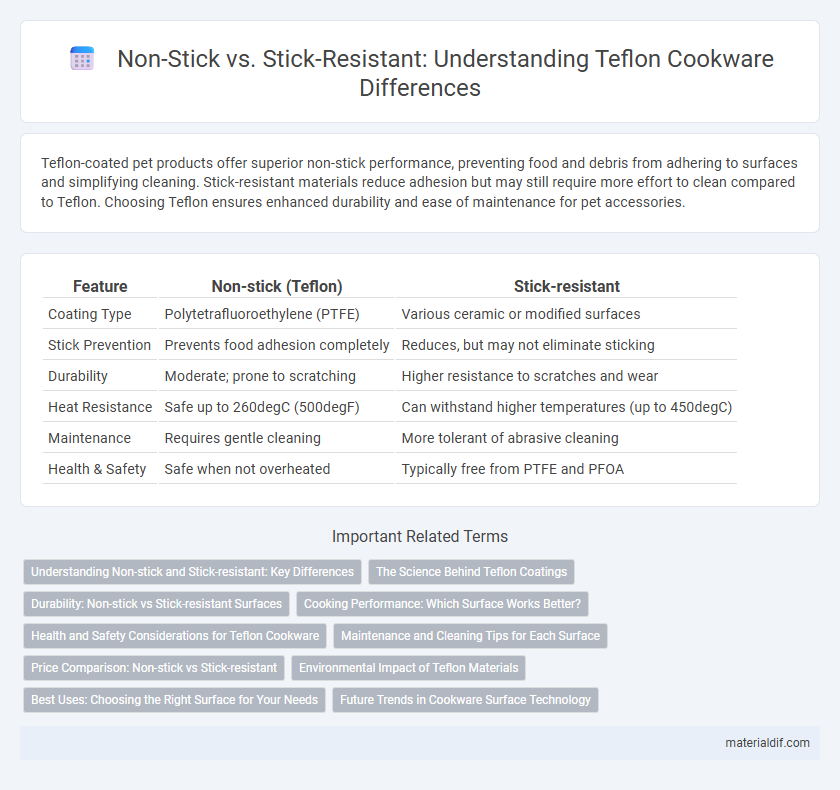Teflon-coated pet products offer superior non-stick performance, preventing food and debris from adhering to surfaces and simplifying cleaning. Stick-resistant materials reduce adhesion but may still require more effort to clean compared to Teflon. Choosing Teflon ensures enhanced durability and ease of maintenance for pet accessories.
Table of Comparison
| Feature | Non-stick (Teflon) | Stick-resistant |
|---|---|---|
| Coating Type | Polytetrafluoroethylene (PTFE) | Various ceramic or modified surfaces |
| Stick Prevention | Prevents food adhesion completely | Reduces, but may not eliminate sticking |
| Durability | Moderate; prone to scratching | Higher resistance to scratches and wear |
| Heat Resistance | Safe up to 260degC (500degF) | Can withstand higher temperatures (up to 450degC) |
| Maintenance | Requires gentle cleaning | More tolerant of abrasive cleaning |
| Health & Safety | Safe when not overheated | Typically free from PTFE and PFOA |
Understanding Non-stick and Stick-resistant: Key Differences
Non-stick surfaces, such as those coated with Teflon, rely on a smooth polymer layer that prevents food from adhering during cooking, enabling easy release and cleanup. Stick-resistant cookware features treatments or materials designed to minimize sticking but may not entirely prevent it like true non-stick coatings do. Choosing between non-stick and stick-resistant depends on cooking style, with non-stick offering superior release properties, while stick-resistant options often provide enhanced durability and heat tolerance.
The Science Behind Teflon Coatings
Teflon coatings utilize polytetrafluoroethylene (PTFE), a fluoropolymer known for its low surface energy, which minimizes adhesion and enables non-stick properties by preventing food molecules from bonding to the surface. Stick-resistant surfaces reduce friction and allow partial adhesion but do not completely prevent sticking like true non-stick coatings do. The molecular structure of Teflon creates a slippery barrier that resists chemical reactions and heat, making it ideal for cookware and industrial applications requiring durable, easy-to-clean surfaces.
Durability: Non-stick vs Stick-resistant Surfaces
Non-stick surfaces, primarily coated with polytetrafluoroethylene (PTFE) such as Teflon, offer superior release properties but tend to degrade faster under high heat and metal utensil use. Stick-resistant surfaces, often ceramic or anodized aluminum, provide enhanced durability and maintain their resistance to food adhesion longer under rigorous cooking conditions. Choosing between non-stick and stick-resistant coatings depends on the balance desired between effortless food release and long-term surface integrity.
Cooking Performance: Which Surface Works Better?
Non-stick surfaces, such as Teflon, provide superior cooking performance by allowing food to release effortlessly, reducing the need for oils and facilitating easy cleanup. Stick-resistant coatings, while helpful in minimizing food adherence, do not match the smooth, non-reactive qualities of true non-stick materials, often requiring more oil or butter. For efficient cooking and maintaining food integrity, Teflon's non-stick properties deliver a more reliable and consistent experience.
Health and Safety Considerations for Teflon Cookware
Teflon cookware, known for its non-stick properties, minimizes food adhesion, reducing the need for excessive oils and fats, which benefits health through lower calorie intake. Stick-resistant surfaces, while less effective than true non-stick coatings, often employ safer materials that avoid the potential release of toxic fumes associated with overheating Teflon above 500degF (260degC). Health and safety considerations emphasize using Teflon at recommended cooking temperatures and avoiding scratched or damaged pans to prevent exposure to harmful perfluorooctanoic acid (PFOA) and polymer degradation products.
Maintenance and Cleaning Tips for Each Surface
Teflon non-stick surfaces require gentle cleaning with soft sponges and mild detergents to preserve their coating, avoiding abrasive materials that can cause scratches and reduce effectiveness. Stick-resistant surfaces tolerate more rigorous scrubbing but still benefit from routine cleaning to prevent buildup and maintain performance. Regular maintenance, such as avoiding metal utensils and high heat, extends the lifespan of both non-stick and stick-resistant cookware, ensuring optimal cooking results.
Price Comparison: Non-stick vs Stick-resistant
Non-stick cookware, typically coated with polytetrafluoroethylene (PTFE) like Teflon, usually commands a higher price due to its superior non-stick properties and ease of cleaning. Stick-resistant pans, often made from ceramic or anodized aluminum, are generally more affordable but may require more maintenance to prevent food adhesion over time. Consumers seeking budget-friendly options often opt for stick-resistant cookware, while those prioritizing convenience and longevity invest in pricier non-stick alternatives.
Environmental Impact of Teflon Materials
Non-stick Teflon coatings release perfluorooctanoic acid (PFOA) during manufacturing, which poses significant environmental and health risks due to its persistence and bioaccumulation. Stick-resistant Teflon variants use lower levels of hazardous chemicals but may sacrifice durability, leading to more frequent replacement and increased waste. Sustainable alternatives focus on PFOA-free fluoropolymers and improved recycling methods to minimize ecological footprint.
Best Uses: Choosing the Right Surface for Your Needs
Non-stick surfaces like Teflon excel in cooking delicate foods such as eggs and pancakes due to their superior release properties, preventing food from adhering entirely. Stick-resistant coatings, while not entirely non-stick, offer durability and chemical resistance ideal for high-heat applications like searing meats and sauteing vegetables. Choosing between non-stick and stick-resistant surfaces depends on cooking style, heat tolerance, and maintenance preferences to optimize performance and longevity.
Future Trends in Cookware Surface Technology
Future trends in cookware surface technology are shifting from traditional non-stick coatings like Teflon towards advanced stick-resistant materials that offer greater durability and higher heat tolerance. Innovations include ceramic-infused coatings and diamond-reinforced surfaces that reduce chemical emissions while maintaining excellent food release properties. These developments aim to enhance sustainability and health safety, addressing consumer demand for longer-lasting, eco-friendly cookware solutions.
Non-stick vs Stick-resistant Infographic

 materialdif.com
materialdif.com